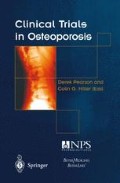Abstract
It is the design of your study that will give it credence in the wider scientific community. If it is clear from the dissemination of the study that there has not been a clear hypothesis, endpoints are inappropriate and the study design inadequate, then it is unlikely that the outcome of the study will be used to contribute to the process of regulatory approval, or form part of a meta-analysis. It is important to get the design right from the start. The time taken will be well worth it.
Access this chapter
Tax calculation will be finalised at checkout
Purchases are for personal use only
Preview
Unable to display preview. Download preview PDF.
References
Guidelines for the Preclinical and Clinical Evaluation of Agents used in the Prevention or Treatment of Postmenopausal Osteoporosis. FDA, 1994 (http://www.fda.gov/cder/guidance/osteo.pdf).
Deeks J, Glanville J, Sheldon T. Undertaking Systematic Reviews of Research on Effectiveness. CRD Report 4, NHS Centre for Reviews and Dissemination, University of York, 1996.
Liberman UA, Weiss SR, Broil J et al. Effect of oral alendronate on bone mineral density and the incidence of fractures in postmenopausal osteoporosis. N Engl J Med 1995; 333: 1437–43.
Sahota O, San P, Cawte SA, Pearson D, Hosking DJ. A comparison of the longitudinal changes in quantitative ultrasound with dual-energy X-ray absorptiometry: the four-year effects of hormone replacement therapy. Osteoporos Int 2000; 11: 52–8.
Cranney A, Tugwell P, Cummings S et al. Osteoporosis Clinical Trial Endpoints: Candidate Variables and Clinimetric Properties. J Rheumatol 1997; 24: 1222–9.
Notes for Guidance on Postmenopausal Osteoporosis in Women. Committee for Proprietary Medicinal Products (CPMP), 2001 (http://www.emea.eu.int/pdfs/human/ewp/055295en.pdf).
Eastell R, Cedel S, Wahner HW, Riggs BL, Melton LJ. Classification of vertebral fractures. J Bone Miner Res 1991; 6: 207–15.
Black DM, Cummings SR, Stone K, Hudes E, Palermo L, Steiger P. A new approach to defining normal vertebral dimensions. J Bone Miner Res 1991; 6: 883–92.
McCloskey EV, Spector TD, Eyres KS et al. The assessment of vertebral deformity: A method for use in population studies and clinical trials. Osteoporos Int 1993; 3: 138–47.
Cook DJ, Guyatt GH, Adachi JD et al. Development and validation of the mini-osteoporosis quality of life questionnaire (OQLQ) in osteoporotic women with back pain due to vertebral fractures. Osteoporosis Quality of Life Study Group. Osteoporos Int 1999; 10: 207–13.
Randell AG, Bhalerao N, Nguyen TV et al. Quality of life in osteoporosis: reliability, consistency, and validity of the Osteoporosis Assessment Questionnaire. J Rheumatol 1998; 25: 1171–9.
Helmes E, Hodsman A, Lazowski D et al. A questionnaire to evaluate disability in osteoporotic patients with vertebral compression fractures. J Gerontol A Biol Sci Med Sci 1995; 50: M91–8.
Lips P, Cooper C, Agnusdei D et al. Quality of life in patients with vertebral fractures: validation of the Quality of Life Questionnaire of the European Foundation for Osteoporosis (QUALEFFO). Working Party for Quality of Life of the European Foundation for Osteoporosis. Osteoporos Int 1999; 10: 150–60.
Ware JE Jr, Gandek B. Overview of the SF-36 Health Survey and the International Quality of Life Assessment (IQOLA) Project. J Clin Epidemiol 1998; 51: 903–12.
Hurst NP, Kind P, Ruta D, Hunter M, Stubbings A. Measuring health-related quality of life in rheumatoid arthritis: validity, responsiveness and reliability of EuroQol (EQ-5D). Br J Rheumatol 1997; 36: 551–9.
Tilyard MW, Spears GF, Thomson J, Dovey S. Treatment of postmenopausal osteoporosis with calcitriol or calcium. N Engl J Med 1992; 326: 357–62.
Pocock SJ Clinical Trials: A Practical Approach. Chichester: John Wiley & Sons. 1983.
International Conference on Harmonization: Guidance on Statistical Principles for Clinical Trials. Federal Register 1998;63:49583–98. (Available at http://www.fda.gov/cder/guidance/91698.pdf)
Kim. JS. Determining Sample Size for Testing Equivalence. Medical Device and Diagnostic Industry. May 1997:114–117. (Available at http://www.devicelink.com/mddi/archive/97/05/ 020.html)
Ettinger B, Pressman A, Silver P. Effect of age on reasons for initiation and discontinuation of hormone replacement therapy. Menopause 1999; 6: 282–9.
Faulkner DL, Young C, Hutchins D, McCollam JS. Patient noncompliance with hormone replacement therapy: a nationwide estimate using a large prescription claims database. Menopause 1998; 5: 226–9.
Vestergaard P, Hermann AP, Gram J et al. Improving compliance with hormonal replacement therapy in primary osteoporosis prevention. Maturitas 1997; 28: 137–45.
Cummings SR, Black DM, Thompson DE et al. Effect of alendronate on risk of fracture in women with low bone density but without vertebral fractures: results from the Fracture Intervention Trial. JAMA 1998; 280: 2077–82.
Cole RP, Palushock S, Haboubi A. Osteoporosis management: physicians’ recommendations and women’s compliance following osteoporosis testing. Women Health 1999; 29: 101–15.
Kurland ES, Cosman F, McMahon DJ, Rosen CJ, Lindsay R, Bilezikian JP. Parathyroid hormone as a therapy for idiopathic osteoporosis in men: effects on bone mineral density and bone markers. J Clin Endocrinol Metab 2000; 85: 3069–76.
Stewart AF, Cain RL, Burr DB, Jacob D, Turner CH, Hock JM. Six-month daily administration of parathyroid hormone and parathyroid hormone-related protein peptides to adult ovariectomized rats markedly enhances bone mass and biomechanical properties: a comparison of human parathyroid hormone 1–34, parathyroid hormone-related protein 1–36, and SDZ-parathyroid hormone 893. J Bone Miner Res 2000; 15: 1517–25.
Hodsman AB, Kisiel M, Adachi JD, Fraher LJ, Watson PH. Histomorphometric evidence for increased bone turnover without change in cortical thickness or porosity after 2 years of cyclical hPTH(1–34) therapy in women with severe osteoporosis. Bone 2000; 27: 311–18.
Altman DG. Better reporting of randomised controlled trials: the CONSORT statement. BMJ 1996; 313: 570–1.
ICH Harmonized Tripartite Guideline E6 Good Clinical Practice: Consolidated Guidance (http://www.fda.gov/cder/guidance/959fnl.pdf).
Rice PL, Ezzy D. Qualitative Research Methods: A Health Focus. Oxford University Press, 1999.
Holloway W, Jefferson T. Doing Qualitative Research Differently. London. Sage Publications, 2000.
Editor information
Editors and Affiliations
Rights and permissions
Copyright information
© 2002 Springer-Verlag London
About this chapter
Cite this chapter
Pearson, D., Miller, C.G. (2002). Study Design and Endpoints. In: Pearson, D., Miller, C.G. (eds) Clinical Trials in Osteoporosis. Springer, London. https://doi.org/10.1007/978-1-4471-3710-8_2
Download citation
DOI: https://doi.org/10.1007/978-1-4471-3710-8_2
Publisher Name: Springer, London
Print ISBN: 978-1-85233-229-7
Online ISBN: 978-1-4471-3710-8
eBook Packages: Springer Book Archive

